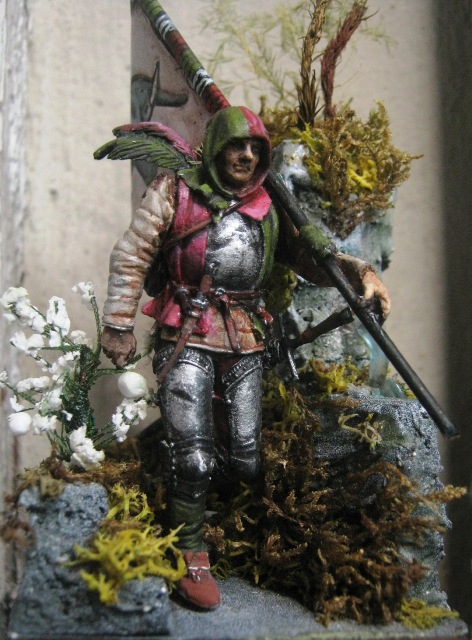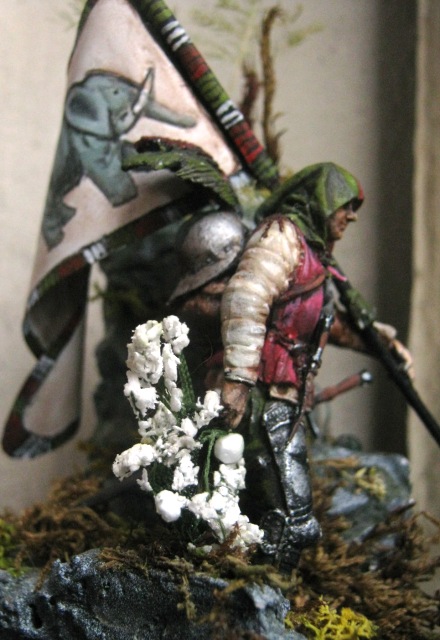Nella simbologia malatestiana l’elefante indiano riveste un ruolo di primissimo piano, raffigurato su medaglie, statue, bassorilievi è spesso accompagnato dal motto “l’elefante indiano non teme le zanzare” a simboleggiare che il potente non si cura dei fastidi procurati dai piccoli.
Simbolo di forza ed operosità, l’elefante indiano, è anche rappresentato sulle bandiere malatestiane, come raffigurato anche nell’Hesperis di Basinio da Parma. Il manoscritto dell’agiografo di Sigismondo Pandolfo racconta la vittoriosa campagna del condottiero riminese, al soldo di Firenze, contro le truppe del Regno di Napoli per il controllo della Maremma.
Il figurino rappresenta proprio un portastendardo malatestiano impegnato nella campagna che culminerà con la battaglia di Piombino nel 1447. Il portastendardo è in tenuta di marcia ed indossa un petto da fante e dei cosciali sopra gambeson e braghe. I colori del portastendardo sono quelli tipici del Malatesta, rosso, bianco e verde, colori riportati anche sulle piume dell’elmo che porta appeso alla sacca sulla schiena.
Il figurino è la semplice conversione dell’alabardiere della “first guard” ormai non più in produzione, con la sostituzione dell’alabarda con la bandiera e con l’aggiunta dell’elmo piumato.
“The Indian elephant does not fear mosquitoes” – Malatesta’s standard bearer
In the malatestian simbology the Indian elephant plays a major role, portrayed on medals, statues, bas-reliefs is often accompanied by the motto “the Indian elephant does not fear mosquitoes” to symbolize that the powerful do not care the small annoyances.
A symbol of strength and hard work, the Indian elephant, is also represented on the warflags of Malatesta, as also depicted nell’Hesperis of Basinio from Parma. The manuscript tells the victorious campaign of the leader of Rimini,Sigismondo Pandolfo Malatesta, in the pay of Florence, against the troops of the Kingdom of Naples to get the control of the south of Tuscany.
The figure is just a Malatesta’s standard bearer involved in the campaign leading up to the Battle of Piombino in 1447. The bearer is in marching and wearing an armoured infantryman chest and legs above gambeson and pants. The colors are typical of the Malatesta, red, white and green, colors also reported on the feathers of the helmet that bears hanging the bag on his back.
The figure is the simple conversion from a “first guard” figure no longer in production, with the replacement dell’alabarda with the flag and with the addition of the plumed helmet.
mail : francescosbarile@yahoo.it






Commenti chiusi.